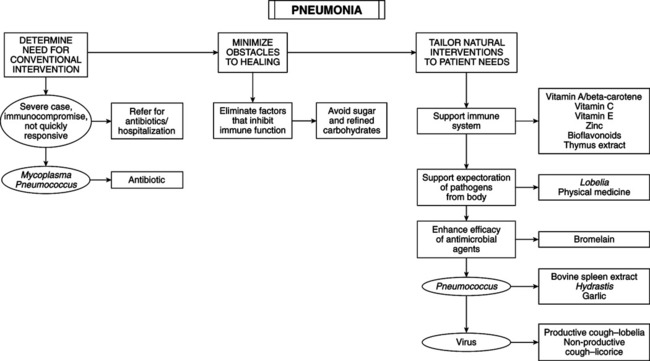• Airway distal to the larynx is normally sterile; mucus-covered ciliated epithelium propels sputum to larger bronchi and trachea, evoking a cough reflex. Respiratory secretions contain substances with nonspecific antimicrobial actions: alpha-1-antitrypsin, lysozyme, and lactoferrin. Alveolar defenses are alveolar macrophages, a rich vasculature to deploy lymphocytes and granulocytes rapidly, and an efficient lymphatic drainage network. • Immunoglobulin (Ig) A: abundant in secretions of the upper respiratory tract. It protects against viruses. In the lower tract, IgA helps: — Reduce bacterial attachment to mucosal surfaces — Activate alternative complement pathway when complexed with an antigen • IgG is present in the lower respiratory tract; it: • Expectorants (botanical): impaired cough reflexes are theorized to play a role in recurrent pneumonia; these botanicals help this condition and prevent recurrences. Botanical expectorants increase quantity, decrease viscosity, and promote expulsion of secretions of the respiratory mucosa. Many have antibacterial and/or antiviral activity. Some are antitussives.Lobelia inflata helps promote cough reflex; it is much more effective in clearing the lungs than the antitussive Glycyrrhiza glabra (licorice). • Other useful expectorants: balsam of Peru, senega root, grindelia, wild cherry bark, horehound • Bromelain: a mucolytic (discussed under pneumococcal pneumonia later). • Vitamin C: effective in large doses only when started on the first or second day of infection. If started later, it only lessens severity. In pneumonia, white blood cells (WBCs) uptake large amounts of vitamin C. In elderly patients vitamin C increased tissue vitamin C, even during acute respiratory infection. Patients fared much better than those on placebo. The most obvious benefit is in patients with most severe illness. • Vitamin A: valuable in pneumonia, especially in children with measles because of the increased rate of excretion of vitamin A during severe infection. Study subjects with fever excreted much more retinol than did those without fever. A dosage of 400,000IU (120 mg retinyl palmitate, half on admission and half a day later) given to children with measles reduced the death rate by >50% and duration of pneumonia, diarrhea, and hospital stay by 33%. Positive associations have been noted with vitamin A and concurrent zinc supplements. In children aged 6 months to 3 years, those given initial high doses of vitamin A followed by 4 months of elemental zinc (10 mg/day for infants and 20 mg/day for children older than 1 year) had reduced incidence of pneumonia that was not present in the group given only vitamin A. • Vitamin E: influenza complicated by pneumonia induces a sharp rise in lipid peroxides. Alpha-tocopherol decreases lipid peroxides and improves clinical response. • Bromelain: a useful adjunct therapy with fibrinolytic, antiinflammatory, and mucolytic actions. It enhances antibiotic absorption. Mucolysis is responsible for its efficacy in respiratory tract diseases such as pneumonia, bronchitis, sinusitis. • Bottle blowing: reduced length of hospitalization for community-acquired pneumonia. Patient instructions: sit up and blow bubbles in a bottle containing 10 cm water through a plastic tube 20 times on 10 occasions daily. This exercise also reduces the number of days with fever. Early mobilization itself decreases hospital stays in patients with pneumonia. Despite positive clinical results, C-reactive protein, peak expiratory flow, and vital capacity are not significantly affected. Respiratory pressure changes induced by this exercise may improve bacterial clearance. This technique decreases pulmonary function impairment and increases total lung capacity in patients after coronary artery bypass. To decrease the frequency of respiratory infections such as pneumonia and limit their duration, consider this or similar activity, such as playing a wind instrument.
Pneumonia: Bacterial, Mycoplasmal, and Viral
GENERAL CONSIDERATIONS
Immunoglobulin Respiratory System Defenses
THERAPEUTIC CONSIDERATIONS: ALL TYPES OF PNEUMONIA
![]()
Stay updated, free articles. Join our Telegram channel

Full access? Get Clinical Tree


Basicmedical Key
Fastest Basicmedical Insight Engine

